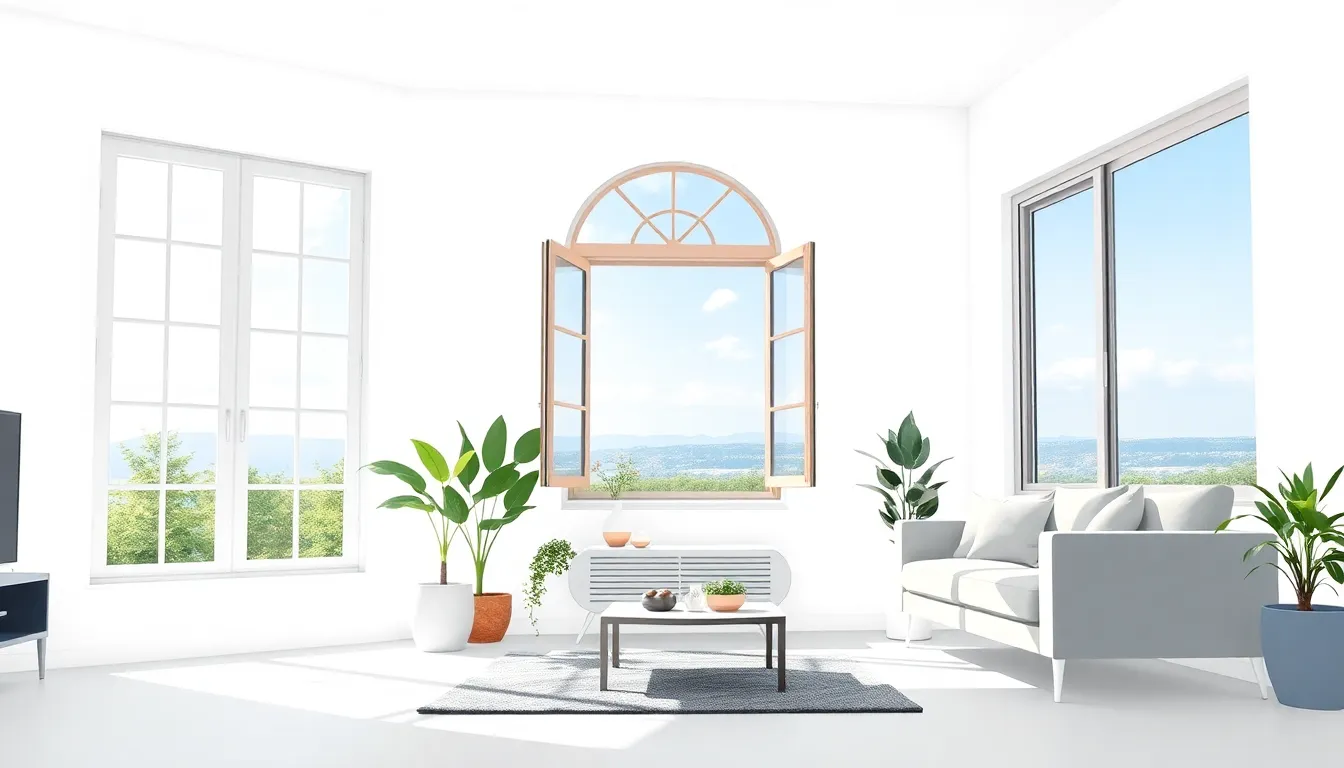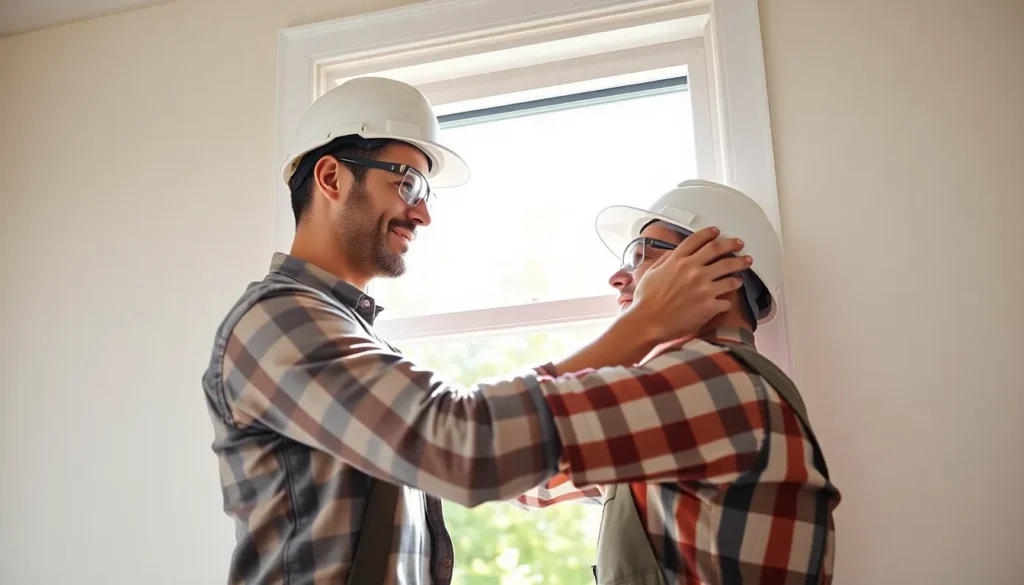When it comes to home improvement, window installation might not be the first thing that pops into your mind. But think about it—those old, drafty windows are like that one friend who always shows up uninvited and leaves the door wide open. It’s time to kick them to the curb and let in some fresh air, sunshine, and a little bit of style!
Table of Contents
ToggleOverview of Window Installation
Window installation involves replacing or fitting new window units into existing frames. This process not only upgrades aesthetics but also improves energy efficiency. An assessment of the current windows’ condition guides the installation process.
The initial step entails selecting appropriate window types for the specific home. Options include double-hung, casement, or sliding windows. Each type provides unique features suited to different preferences.
Measurements are crucial in ensuring proper fitting. Precise measurements help avoid gaps that could lead to air leaks. Therefore, removing old windows typically follows measurement verification.
After ensuring measurements are accurate, preparation of the opening occurs. This step includes cleaning the frame and checking for any structural issues. Addressing existing problems before installation enhances long-term performance.
In the actual installation, positioning the new window requires care. It must sit level and plumb for optimal functionality. Insulation installation around the frame ensures added energy efficiency.
Sealing the window properly is vital for preventing moisture intrusion. Weather stripping and caulking play essential roles in this part of the installation. Each component contributes to the overall integrity of the window.
Finishing touches, such as interior and exterior trim, enhance the appearance of the installation. This final aspect ties the window seamlessly into the home’s design.
Regular maintenance post-installation helps prolong window life and efficiency. Homeowners should inspect seals and tracks periodically. By addressing small issues early, they can prevent larger problems down the road.
Types of Windows for Installation

Various window types suit different preferences and styles during installation. Each type offers specific benefits and aesthetic appeal.
Double-Hung Windows
Double-hung windows feature two operable sashes that slide up and down. This design allows for easy ventilation and cleaning, as both sashes can tilt inward. A classic look complements many architectural styles. Homeowners appreciate their versatility and ease of use. Additionally, these windows often enhance energy efficiency when properly sealed.
Casement Windows
Casement windows open outward, pivoting from one side. This design provides excellent ventilation, as the entire window expanse opens to the outside. Enhanced energy efficiency is a key feature, thanks to their tight seal when closed. Available in various sizes, casement windows fit different spaces and aesthetic preferences. They often create a modern and unobstructed view, adding to the room’s character.
Sliding Windows
Sliding windows consist of two or more sashes that slide horizontally. This design allows for unobstructed views and easy operation. Homeowners often prefer them for their space-saving qualities, as they don’t require extra room to swing open. Enhanced natural light contributes positively to indoor ambiances. Many sliding windows come with energy-efficient features, providing both comfort and style.
The Window Installation Process
The window installation process involves several essential steps. Each step contributes to achieving optimal performance and aesthetics.
Measuring the Opening
Accurate measurements stand as the foundation of a successful window installation. Homeowners should begin by measuring the width and height of the existing window frame. Consider measuring at three different points: the top, middle, and bottom for width, and the left, center, and right for height. By determining the smallest measurements, one ensures a precise fit that eliminates air leaks. Mark these measurements clearly for easy reference during the installation process. Taking time to measure correctly simplifies later steps, preventing complications from improperly sized windows.
Preparing the Area
Preparation of the area plays a crucial role in achieving a successful installation. Start by removing the old window and carefully dismantling any trim or molding. Any accumulated debris and dust from the frame must get cleaned to create a stable surface. Inspect the opening for signs of rot or damage. If any structural issues are found, they require prompt attention to ensure the new window fits securely. Protect surrounding areas with drop cloths to prevent damage during installation. Taking these precautions contributes to a seamless and efficient installation process.
Installing the Window
Careful installation techniques ensure long-lasting window performance. Position the new window into the prepared opening, checking that it fits snugly. Level and plumb the window by adjusting shims for optimal placement. Secure it with screws or nails as recommended by the manufacturer. Following installation, add insulation around the frame to enhance energy efficiency. Proper sealing with caulk around the outer edges prevents moisture intrusion, safeguarding against leaks. Finishing touches, like reinstalling trim, elevate the overall appearance. Completing these steps guarantees a well-installed window that complements the home’s aesthetics while providing improved energy efficiency.
Common Challenges in Window Installation
Homeowners often face several challenges during window installation that can impact the overall success of the project. One significant issue involves inaccurate measurements, leading to ill-fitting windows. Ensuring precise measurements at multiple points can help avoid this dilemma.
Another common concern is dealing with old and damaged frames. Structural issues may arise, requiring repairs before new windows can be installed. This adds both time and cost to the project, necessitating thorough inspections prior to installation.
Selecting the right window type can also prove problematic. Each window style, such as double-hung or casement, offers unique features and benefits. Homeowners must carefully consider their needs and preferences during this selection process to maximize energy efficiency and aesthetics.
Improper weather sealing frequently becomes a major challenge. Inadequate sealing can lead to air leaks and moisture intrusion, undermining energy efficiency. Applying weather stripping and caulking correctly is vital for long-term performance.
Positioning the window accurately contributes to installation success. Windows must be level and plumb, affecting how they function and appear. Taking the time to adjust and secure the window properly pays dividends in functionality.
Lastly, homeowners may overlook finishing touches, which can detract from the overall look of the installation. Adding trim enhances the appearance while also providing additional insulation benefits. Maintaining a focus on these details ensures an effective and visually appealing result.
Recognizing these challenges can lead to informed decisions, enhancing the overall window installation experience while increasing comfort and efficiency in the home.
Benefits of Professional Window Installation
Engaging professionals for window installation brings multiple advantages. Expertise ensures that every measurement taken is precise, reducing the risk of future air leaks. Quality materials often accompany professional installation, enhancing energy efficiency further. Homeowners benefit from warranties that cover both windows and installation service, protecting their investment long-term.
Safety is another crucial factor. Professionals handle large glass panels, minimizing the risks of injuries or damages. Experience with various window types allows them to suggest the best options for individual needs, increasing overall satisfaction. Attention to detail during installation translates to better aesthetics, making homes more visually appealing.
Time savings also stand out. Professionals complete installations efficiently, relieving homeowners from navigating the complexities of the process. Knowledge of local building codes ensures that installations comply with regulations, avoiding potential fines or issues in the future. Sound insulation benefit comes from proper sealing techniques employed by professionals, leading to quieter indoor environments.
Energy efficiency becomes easier to achieve. Well-installed windows reduce heating and cooling costs, adding up to substantial savings over time. A professional’s ability to address structural issues during the installation process ensures a secure and lasting fit, bolstering overall durability. Enhanced curb appeal results from clean, professional finishes that elevate the home’s exterior.
Additionally, regular maintenance provided by professionals keeps windows functioning optimally. Professional inspections help uncover minor problems before they escalate, promoting longer window life. Increased property value reflects the quality of an expertly installed window, appealing to potential buyers. Homeowners obtain peace of mind knowing their windows are installed correctly and efficiently, enhancing their living environment dramatically.
Upgrading windows is a vital step in enhancing a home’s comfort and energy efficiency. By investing in quality installation and selecting the right window types, homeowners can enjoy improved aesthetics and functionality.
Engaging professionals for the installation process ensures accuracy and adherence to building codes, which can prevent future issues. With proper maintenance and regular inspections, the benefits of new windows can be maximized, contributing to a more pleasant living environment.
Ultimately, the decision to replace old windows can lead to significant improvements in both quality of life and property value.





